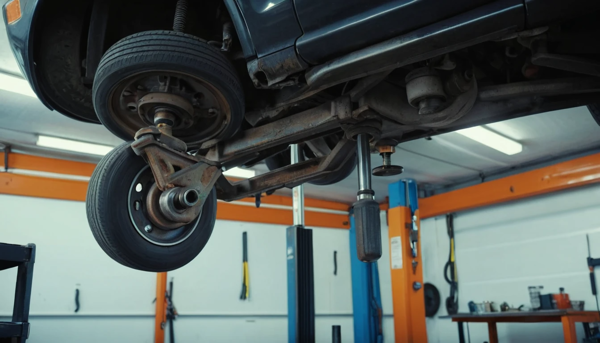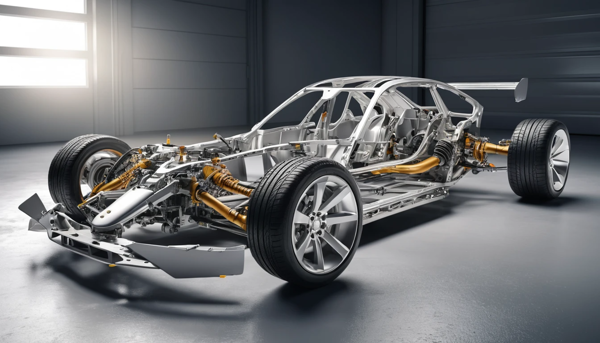How does Magnetic Ride Control work? Discover the science behind silky-smooth, adaptive suspension in luxury vehicles.
How Does Magnetic Ride Control Work? 🧲✨
Ever wondered how some luxury cars seem to glide over bumps like they’re floating? What’s the secret behind that buttery-smooth ride that makes potholes feel like tiny pebbles? The answer might surprise you—it’s Magnetic Ride Control (MRC), one of the smartest suspension systems ever built into a vehicle.
Let’s break it down in plain English. This isn’t just car jargon. It’s science, tech, and everyday comfort working together to give you the smoothest ride of your life. 😎
What Is Magnetic Ride Control? 🚗
Magnetic Ride Control is an advanced adaptive suspension system that adjusts your car’s shock absorbers in real time. Unlike traditional suspensions, it uses magnetorheological fluid—a type of liquid that changes its viscosity when exposed to a magnetic field.
In simple terms? It’s like liquid magic that stiffens or softens your shocks depending on the road. 💫
What Makes Magnetic Ride Control So Unique? 🧪
Here’s what sets it apart:
- No moving mechanical valves
- Ultra-fast reaction times—adjusts in milliseconds
- Uses smart sensors to scan the road
- Offers a perfect mix of comfort and performance
- Works automatically, no driver input needed
This tech is found in high-end vehicles like Cadillac, Corvette, Audi, and some Ferraris.
The Science Behind the Magic 🧲
At the core of Magnetic Ride Control lies magnetorheological (MR) fluid. This fluid contains tiny iron particles suspended in oil. When a magnetic field is applied, the particles align and make the fluid thicker. When the magnetic field is off, the fluid flows easily.
Here’s the process in a nutshell:
- Sensors detect road conditions.
- A computer sends signals to electromagnets.
- Magnetic fields change the MR fluid’s stiffness.
- Shock absorbers instantly adjust damping.
- Result: A super-smooth ride tailored to each moment.
How Sensors Make It Smart 🧠
Magnetic Ride Control systems rely on sophisticated sensors. These sensors monitor:
- Wheel position
- Vehicle speed
- Body movement
- Steering angle
- Acceleration and braking forces
All this data is processed more than 1,000 times per second. That’s faster than a blink!
Magnetic Ride Control vs Traditional Suspension 🛠️
Let’s compare them side-by-side:
| Feature | Magnetic Ride Control | Traditional Suspension |
|---|---|---|
| Damping Adjustments | Real-time (milliseconds) | Static or slow |
| Comfort Level | High | Moderate |
| Performance | Excellent handling | Average |
| Maintenance | More complex | Easier and cheaper |
| Cost | Higher upfront | Lower upfront |
Is Magnetic Ride Control Only for Sports Cars? 🏎️
Nope! While it did start in sports cars, now it’s in:
- Luxury sedans 🚘
- SUVs 🚙
- Crossovers 🚐
Even family cars are getting smarter. It’s not just about speed. It’s about comfort, control, and confidence.
The Real-World Benefits of MRC 🎯
Wondering what’s in it for you? Here are some real perks:
- Reduced body roll when cornering
- Better traction in rough terrain or rain
- Smooth transitions between road surfaces
- Automatic adjustment to load changes (passengers/cargo)
- Less fatigue on long drives
All this means you get a ride that feels tailor-made, every time.
What Happens Inside the Shock Absorbers? 🔍
Let’s get a bit nerdy (but keep it simple):
| Component | What It Does |
|---|---|
| Damper piston | Moves inside the cylinder, affects fluid flow |
| MR fluid | Adjusts viscosity based on magnetic field |
| Electromagnet coil | Creates the magnetic field |
| Sensors and ECU | Brain of the system; interprets road data |
This self-contained system eliminates the need for clunky mechanical valves. It’s sleek, silent, and seriously smart. 🤓
Can You Feel the Difference While Driving? 🛣️
Absolutely. Once you drive a vehicle with MRC, you won’t want to go back. You’ll notice:
- Less bounce on speed bumps
- No harsh thuds on potholes
- Stable, responsive handling around curves
- Confidence during emergency braking
Drivers often say it feels like gliding. And that’s not an exaggeration.
Does It Affect Fuel Efficiency? ⛽
Good news: it doesn’t hurt fuel economy. The system is lightweight and only uses energy when needed. This means it has a small impact.
So, you get superior comfort without draining your tank.
How Reliable Is Magnetic Ride Control? 🛡️
While the tech is advanced, MRC is known for durability. But, repairs can be pricey if something goes wrong.
Here are a few tips to keep it running smoothly:
- Stick to your vehicle’s service intervals
- Watch for fluid leaks
- Don’t ignore unusual noises or rough ride
- Keep tire pressure optimal (impacts sensor readings)
Is It Worth the Extra Cost? 💸
Let’s break it down:
| Feature | Value |
|---|---|
| Ride Comfort | ⭐⭐⭐⭐⭐ |
| Handling | ⭐⭐⭐⭐⭐ |
| Maintenance Cost | ⭐⭐☆☆☆ |
| Longevity | ⭐⭐⭐⭐☆ |
| Overall Driving Experience | ⭐⭐⭐⭐⭐ |
If comfort and handling matter to you—and you’re willing to invest in your ride—it’s worth every penny.
Which Cars Offer Magnetic Ride Control? 🚙
Here are some popular models that include (or offer) MRC:
- Chevrolet Corvette
- Cadillac Escalade
- Buick Enclave Avenir
- GMC Sierra Denali
- Audi TT RS
- Ferrari 488 GTB
From muscle cars to SUVs, this feature is becoming more mainstream.
Can You Upgrade Your Car With MRC? 🔧
In most cases, no. Magnetic Ride Control is integrated into a vehicle’s suspension system and requires built-in support from the factory. Retrofitting it is expensive and technically challenging.
If you want MRC, look for it as a factory option when buying a new vehicle. 🆕
Final Thoughts: The Future Is Magnetic 🚀
Magnetic Ride Control is more than a luxury—it’s a leap forward in suspension technology. With adaptive intelligence, real-time adjustments, and effortless comfort, it’s no wonder this system is becoming standard in premium cars.
Whether you’re navigating tight city streets or cruising on open highways, MRC ensures your ride is always smooth, safe, and enjoyable.
Next time you test-drive a car, ask if it has Magnetic Ride Control—you’ll feel the difference. 💯
FAQs
What is magnetic ride control and how does it work?
It’s a smart suspension system that uses magnetic fluid and sensors to adjust your shocks in real time for a smoother ride.
Is magnetic ride control better than air suspension?
They serve different needs. MRC offers quicker response and better handling, while air suspension focuses more on ride height and cushion.
Can magnetic ride control be turned off?
You can’t completely turn it off, but you can switch between comfort and sport modes, which change how it behaves.
Does magnetic ride control help in snow or rain?
Yes! It improves traction and adjusts damping to keep your tires planted, even on slippery surfaces.
How long does magnetic ride control last?
With regular maintenance, it can last over 100,000 miles, but repairs may cost more than standard shocks.
References
https://www.cadillac.com/world-of-cadillac/innovation/magnetic-ride-control
https://www.chevrolet.com/performance/magnetic-ride-control
https://www.caranddriver.com/features/a15081531/magnetorheological-dampers-explained-tech-dept/







Leave a Reply